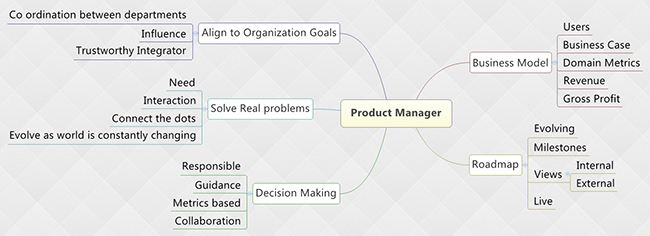
Is it Time to Fire Your Product Manager?
Product Managers are a hot commodity these days. Whether you are an industry behemoth or a fledgling up-start, talented Product Managers can make the difference between driving sustainable growth or fading out of memory and eventually going bust. The industry has recognized the value of this role and is aggressively trying to hire. A search for ‘Product Manager’ on LinkedIn Jobs yields close to 15,000 results in the NYC area alone! The disparity between supply and demand is forcing rushed hiring practices that result in mediocre to bad Product Managers who oversee half-baked product strategies and lousy implementations.

We observe product failures every day and across many industries - whether it’s gaming consoles, transparent yoga pants or the now infamous US government's dismal attempt to launch a digital channel for providing healthcare to its citizens. As business technology consultants, we also have the pleasure of engaging with these Product Managers almost on a daily basis (not just the bad ones). In our opinion, product management is an evolving discipline and unfortunately the ambiguity of the role’s definition (depending on the organization) is one of the critical factors behind undesirable hires and bad outcomes.
Our research also indicates that today's most successful product management teams are not only highly responsive to changes in market conditions, but are highly focused and communicative of their intent, and are always trying to outpace the competition. We believe that Product Managers who succeed at creating exceptional products and new service ecosystems are a rare breed; the others should seek work in a different capacity. So, while there are no surefire ways of hiring a good Product Manager, here are five red flags to watch out for as you assess your current product management team and decide if it’s time to let them go.

Reason #1 Product Managers building products without a fundamental business model
For any given product (or a new feature in a product), the business model is critical to success. Key to that model are the estimations that support it - users, customers, visits, footfalls, revenue, gross profit - metrics that are relevant to your domain. However, to justify continued investment in a product, average Product Managers often avoid explaining their assumptions and rely heavily on hand waving and fabrication to explain key values.
In 2010, Solyndra was granted a $535 million loan by the US Department of Energy (DoE) to build a new 28,000 square meter plant. In the meantime, Solyndra’s competitors we’re producing solar panels at $1.20 per watt (per SEC filings) while Solyndra couldn’t get the cost of their panels below $3 per watt. The product team at Solyndra failed to realize that competitor’s were leveraging falling prices of key raw materials to greatly reduce the price of a panel. After producing only 500,000 panels, Solyndra was forced to shut down and the US DoE was forced to write-off the loan; certainly not what taxpayers were hoping for.
If your Product Manager cannot pull together an informed and rational model for product/service adoption, with high-level estimates, and explain the supporting reasons and assumptions, then that Product Manager is draining precious capital without much thought for growth and numbers. We think it’s time to review your product management talent and take appropriate action.
Reason #2 Product Managers creating products without a transparent and evolving road-map
Google infamously retires its products (Google Health, Google Gears, Google Buzz, Google Wave, Google Reader, etc.) when they fail to achieve the success they’d hoped for. While its refreshing to see products killed due to low adoption or not being part of a strategic portfolio, many organizations using these products were forced to consider whether Google’s product strategy fits with their needs for consistency and predictability. These organizations, especially in the public sector, often question the reliability of Google as an enterprise platform partner of choice, given Google’s propensity to kill products based on esoteric metrics and lack of communication of roadmaps. In our opinion, Google can avoid this growing mistrust by being more transparent with their product roadmap.
A portfolio level roadmap, including major milestones and success metrics for products, goes a long way in building trust with internal and external stakeholders. Roadmaps ensure that all business units are aligned. It’s also important to consider the post-launch roadmap. A successful launch does not ensure sustained success. Without proper planning, competitors will creep in and gain market share. The Product Manager is responsible for keeping the roadmap sufficiently updated to reflect the pivots and changes that can alter the product offering or portfolio direction. A living roadmap keeps your organization’s products top-of-mind for all stakeholders; sadly, many Product Managers don’t have the rigor to maintain one.
If your Product Manager is unable to produce and maintain an internal and public facing road-map with sufficient insights, then they are neglecting a great opportunity to build trust with internal stakeholders and customers alike. We think such Product Managers need to revisit their priorities.
Reason #3 Product Managers who are frequently invisible in key decisions
Building products is a social activity; great products are created when people with diverse and complementary skills collaborate on achieving a vision. Product management is a complicated affair requiring skill and experience to make quick and informed decisions while keeping the team focused on delivering value. We strongly believe the Product Manager to be the master composer, orchestrating the creation of the product and protecting the team from the unnecessary requests and demands that come all too frequently.
Sachin Rekhi, a Silicon Valley entrepreneur, speaks eloquently about the art of decision making being an essential quality of successful Product Managers. Ben Horowitz of Andreessen Horowitz recognizes a bad Product Manager as one that’s putting out fires all day and not spending time with the team to make decisions focused on the product and the customer.
If your Product Manager is someone who is absent from key decisions or unable to provide guidance when needed most, then distractions are going to keep the team from meeting the needs of the customers. Also if your Product Manager undermines any action taken in his/her absence, then the team will lose trust in that Product Manager. We strongly recommend replacing that Product Manager with someone who fosters collaborative decision making for customer success and organizational growth.
Reason #4 Product Managers not focused on solving customer problems
Pantone Inc. was founded in the 1950s and is well known for Pantone Matching Systems, a proprietary color tool primarily used in printing. In this new digital age, Pantone have successfully leveraged its proprietary color match capital to introduce new applications that live up to the latest market trends. Pantone recently partnered with Sephora to create ‘Sephora + Pantone Color IQ’ - the first and only beauty ‘device’ (in-store or online) that scans the surface of your skin and recommends flattering Sephora foundations for their skin tone. Digital product innovation of this kind is not possible without focusing on the customer and anticipating how digital technologies can reshape the way customers interact with their favorite brands.
If your Product Manager spends their time capturing meeting minutes or collecting requirements rather than embedding themselves in the user experience, then you should look to embed that Product Manager anywhere but on one of your product development teams.

Reason #5 Product Managers who fail to unite the organization
Product Managers are essential to the product life-cycle; from ideation through design, delivery and beyond, constant coordination is needed across multiple business functions. Unless you run a two person start-up operating out of your parent’s garage, your product management function exists at the intersection of these business functions, all of which are needed to create a successful product. Your Product Manager is expected to align the product roadmap and stakeholders with the strategic vision of leadership; this expectation will not be met if they are unable to navigate the intricate structure that exists in many of today’s complex organizations.
Google’s Sundar Pichai, who runs the Android division, is considered by his colleagues to be one the most diplomatic technology product executives in the company. He gets things done across multiple departments seamlessly simply because he is liked by everyone. This is in sharp contrast to his equally, if not more qualified predecessor, Andy Rubin (the founder of Android), who infamously required a term sheet to work with other divisions within Google.
Having Product Managers who can navigate the inter-departmental seams and get stuff done is essential. If your Product Manager is unable to forge relationships across different functions, or is incapable of aligning each function’s goal with the success of the product, then they are putting that product / product team at an increased risk of failure; you may want to direct them out the door.
Finding a Great Product Manager
Product failures rarely get the publicity that successful launches do. More often than not, these failures are due to the missteps of the product management team. However, for all the ways that Product Managers can fail, a great Product Manager is invaluable to your organizations’ success. It may take some time to find and nurture this talent, but once found, it should be encouraged and cherished.
This one role in an organization can have a profound impact on entire teams of product developers and can ultimately mean success for any product launched. Our hope is that the above mentioned five reasons will help you identify Product Managers who may be doing a disservice to your product development function.
Please note a longer version of this article was originally published on LinkedIn. Senior Product Manager, Ashok Warriar, created this brilliant mind-map to craft a definition for a successful Product Manager.

Disclaimer: The statements and opinions expressed in this article are those of the author(s) and do not necessarily reflect the positions of Thoughtworks.














